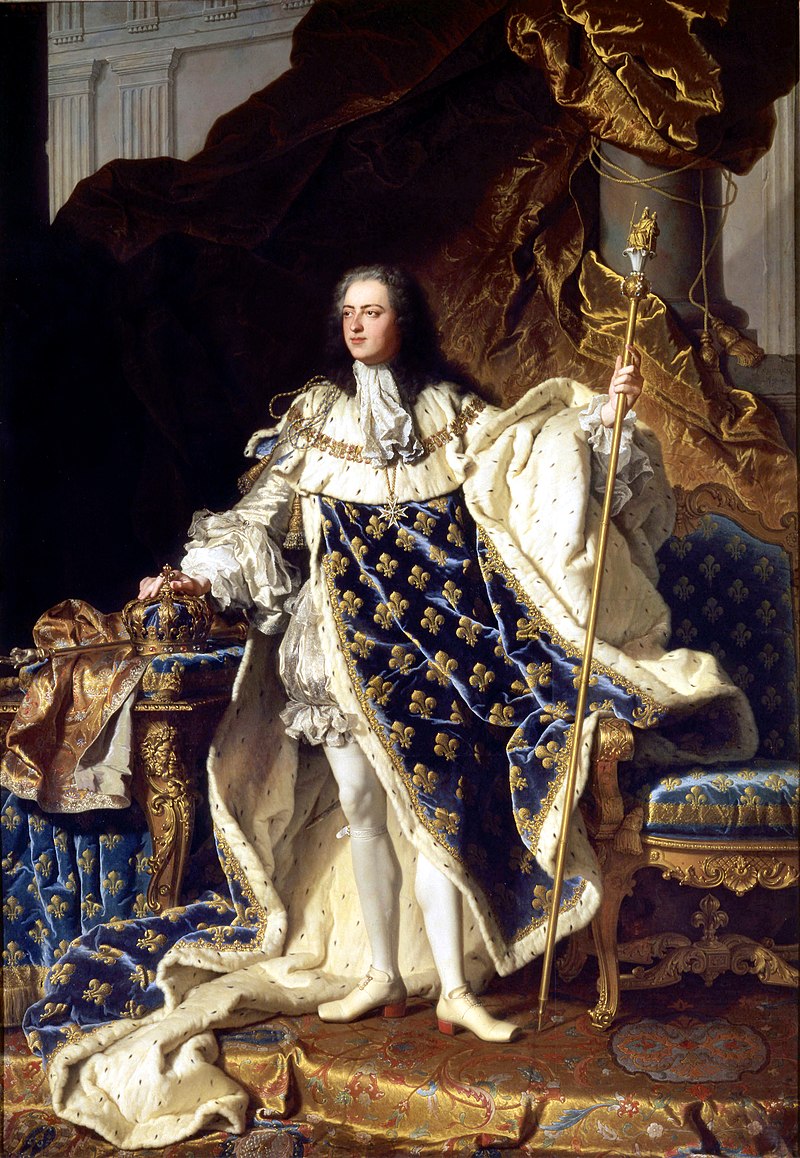by Scott Mehl © Unofficial Royalty 2016

Maria Leszczyńska, Queen of France; Credit – Wikipedia
Maria Karolina Zofia Felicja Leszczyńska was the wife of King Louis XV of France. She was born on June 23, 1703, in Trzebnica, Silesia (now Poland) to Stanisław I Leszczyński and his wife Catherine Opalińska. She had one older sister, Anna (born 1699), who died at the age of 18.
The year after her birth, her father was made King of Poland by King Carl XII of Sweden, who had invaded the country that year. He reigned as King Stanisław I until 1709 when the Swedish forces were defeated. The family took up residence in Kristianstad, Sweden, and became prominent members of Swedish society. They later moved to Zweibrücken, then personal union with Sweden, now in the German state of Rhineland-Palatinate. After the death of King Carl XII, the family moved to Wissembourg in France, where they were largely supported by Philippe I, Duke of Orléans who was serving as Regent for the young King Louis XV. Maria’s father became King of Poland again in 1733, reigning until being forced to abdicate in 1736. He was then created Duke of Lorraine by his son-in-law King Louis XV.

King Louis XV of France; Credit – Wikipedia
After being suggested as a bride for several marriages, Maria was soon proposed as a potential wife for King Louis XV of France. King Louis XV had fallen ill, and being unmarried with no heir, plans were made to arrange a marriage for him as quickly as possible. Although engaged to Infanta Mariana Victoria of Spain, she was still a child and would be unable to provide an heir for quite some time. The engagement was ended, and the young Infanta was sent back to Spain. Meanwhile, Maria was just one of many potential brides and not near the top of the list. Initially removed from the list because of her lack of wealth, she was soon the preferred choice by all parties involved in the marriage discussions.

The marriage of King Louis XV and Maria Leszczyńska, source: Wikipedia
The couple was married by proxy on August 15, 1725, at the Cathedral of Strasbourg, at which point she took the French version of her name, Marie. Marie and Louis, who met the night before their wedding, were married in person in the chapel at the Château de Fontainebleau on September 5, 1725.
Marie and Louise had ten children:
- Louise Élisabeth (1727 – 1759), married Infante Felipe of Spain, Duke of Parma, founder of the House of Bourbon-Parma, had issue
- Anne Henriette (1727 – 1752), unmarried, died of smallpox
- Marie-Louise (1728 – 1733), died in childhood
- Louis, Dauphin of France (1729 – 1765), married (1) Infanta Maria Teresa Rafaela of Spain, had issue (2) Maria Josepha of Saxony, had issue including Louis XVI, King of France, Louis XVIII, King of France and Charles X, King of France
- Philippe of France, Duke of Anjou (1730 – 1733), died in childhood
- Marie Adélaïde (1732 – 1800), unmarried
- Victoire Louise Marie Thérèse (1733 – 1799), unmarried
- Sophie Philippine Élisabeth Justine (1734 – 1782), unmarried
- Marie Thérèse Félicité (1736 – 1744), died in childhood of smallpox
- Louise Marie (1737 – 1787), became a nun, beatified in 1873, and known as Blessed Thérèse of Saint Augustine

Queen Marie with her son, the Dauphin, painted by Alexis Simon Belle, c1730. source: Wikipedia
The marriage of Marie and Louis XV was a success, and the two were very happy and in love. However, after nearly dying during the birth of her last child in 1737, Marie refused her husband’s romantic advances and their relationship quickly fell apart. By that time, King Louis had taken several mistresses, including the famed Madame de Pompadour. These women were often given positions in Queen Marie’s court against her wishes, causing Marie great distress. Only one, Madame de Pompadour, showed Marie the slightest bit of respect, and Marie was able to maintain a friendly relationship with her.
As Queen, Marie maintained the strict protocol and etiquette of the French court and fully embraced her role and responsibilities of her ceremonial role. However, when not at official functions, she preferred to retreat to her private apartments, spending time with a small group of close friends and confidants. She only once made a foray into politics, and that proved disastrous. Shortly after her marriage, Louis Henri, Duke of Bourbon enlisted the new Queen to participate in a plot to banish Cardinal de Fleury from the King’s court. When it failed, it caused a temporary rift with her husband. From that point forward, she resolved to avoid all politics.
A great lover of the arts, she supported several prominent artists and musicians and arranged for weekly Polish choral concerts to be held at the Palace of Versailles. She was also an avid gambler and often found herself in debt.

The tomb of Queen Marie in the Basilica of St. Denis. source: Wikipedia
Queen Marie died at the Palace of Versailles on June 24, 1768. She was buried at the Basilica of St. Denis near Paris, while her heart was entombed at the Church of Notre-Dame-de-Bonsecours in Nancy. Having held her position for nearly 43 years, Queen Marie was the longest-serving Queen consort in the French monarchy.
This article is the intellectual property of Unofficial Royalty and is NOT TO BE COPIED, EDITED, OR POSTED IN ANY FORM ON ANOTHER WEBSITE under any circumstances. It is permissible to use a link that directs to Unofficial Royalty.
France Resources at Unofficial Royalty
